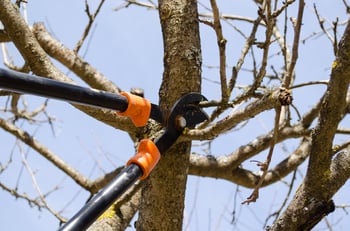After the leaves fall from trees is prime time for dormant winter pruning, that is when a tree's branches are expertly removed by a trained professional who understands how to create a healthy tree canopy. Winter is an ideal time to prune because trees are not actively growing, and there are fewer active pests and diseases.
You might be wondering if dormant pruning is necessary on your commercial property? What is the risk of not dormant pruning? And, if your landscape provider performs dormant pruning, what can you expect?
Let’s address some of those questions here.
Dormant Pruning: A Professional Approach
Professionals have a strategy when pruning trees and approach it systematically.
There are three reasons to dormant prune, and we prioritize pruning like this:
 Tree health: First, trees are pruned to maximize tree health by removing crossed branches and any diseased or dead wood. Trees are pruned to encourage a proper growth habit, including a balanced scaffolding system for strong branching unions.
Tree health: First, trees are pruned to maximize tree health by removing crossed branches and any diseased or dead wood. Trees are pruned to encourage a proper growth habit, including a balanced scaffolding system for strong branching unions.- Safety: Next, we ensure that tree limbs are out of the way for pedestrians and vehicles. We also make sure there is plenty of clearance around buildings.
- Aesthetics: This is the last pruning step. Remember, a properly pruned tree is one that doesn’t look like it was pruned.
Common Pruning Problems To Avoid
First, be sure the expert you hire to dormant prune trees has a degree in horticulture or arboriculture, or is a certified professional such as Landscape Industry Certified or Certified Arborist. Pruning is not as simple as cutting off branches.
There is a system and proper technique to preserve tree health and vitality.
Common problems we see when an inexperienced landscaper performs the job include:
- Topping trees: This compromises the strength and vitality of the tree canopy, and can shorten the life of the tree. Topping trees can also reduce your property value and increase the chance of storm damage.
- Painting wounds: Painting/sealing tree wounds can actually cause more problems. This is no longer an industry best practice.
- Pruning too much: A properly pruned tree should not look pruned at all.
- Not pruning at all: If you pass on dormant pruning, you could potentially compromise pedestrian, vehicle, and building safety while sacrificing tree health and longevity. Dormant pruning benefits the tree’s structure because we prune in a way that will strengthen the overall tree canopy.
 Additionally, you’ve got to be careful when pruning trees with diseases. At Klausing Group, our team is trained to identify common arbor diseases, such as fire blight. They know the signs and symptoms so we can take special precautions to not spread infection when dormant pruning those trees.
Additionally, you’ve got to be careful when pruning trees with diseases. At Klausing Group, our team is trained to identify common arbor diseases, such as fire blight. They know the signs and symptoms so we can take special precautions to not spread infection when dormant pruning those trees.
Dormant Pruning Shrubs: Cutbacks For Size Reduction
Winter is also the best time to dormant prune shrubs. This includes making hard cutbacks on shrubs that have grown too large. For example, we commonly find shrubs that want to be 15 to 30 feet tall planted into tight spaces. These shrubs block views, create hazards and outgrow their location. Winter is the best time to do a hard cutback without sacrificing the overall appearance and health of your landscape. A hard cutback will right-size the shrubs and improve plant health.
Shrub reduction also can enhance safety on your property by improving site lines and removing hiding places.
In extreme cases, certain overgrown shrubs can be cut back to the ground, a process called coppicing. This is only appropriate for varieties that will produce new growth from a stump.
Coppicing your red twig dogwood every third year replaces old wood with new bright red growth and the pruned wood provides festive winter decorations.
Plants that respond to coppicing are those that evolved with fires as part of the natural ecosystem. A fire would destroy the plant, then new growth would sprout from the remains.
A plant expert can advise the best method of dormant pruning for the shrubs on your Kentucky landscape.
Dormant pruning of shrubs can include these more aggressive methods that resize plants; or lighter pruning for health, safety and aesthetics. Winter is the time to do these services.
Dormant Pruning Preserves Your Landscape Investment
Trees are a real asset to your Central Kentucky property. Caring for them is a worthwhile investment. We recommend that property owners ask a qualified landscape provider to include dormant pruning in the annual maintenance contract.
If dormant pruning is determined “as needed,” then allow for a budget to care for trees and shrubs that might need attention. That way, you can protect your plants, and preserve the health, safety and appearance of your landscape.
Let’s talk more about what to include in your landscape maintenance contract. Call us at 859-254-0762 in Lexington and 502-264-0127 in Louisville. Or, fill out this simple contact form and we’ll get in touch with you.


